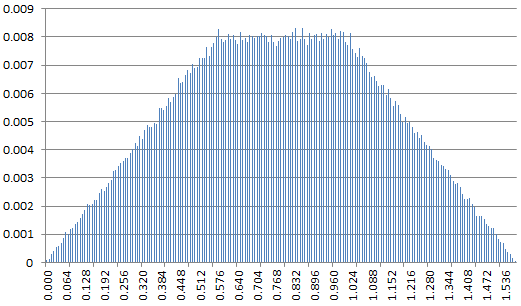I have deleted my previous answer and instead posting this one, which is much more interesting. I investigated the sequence $Y_k=X_{3k}$, which has far more communal planes, and thus more useful to build a random generator. Of course, choosing large values for $b_1,b_2$ will further drastically improve the generator by adding a lot more planes. Here $b_1=5, b_2=3$. I suggest choosing values larger than (say) $2^{30}$ for $b_1,b_2$. Also $X_1=\frac{\sqrt{2}}{2}$.
I found 197 communal planes and they all have an equation of the form
$$Y_k+\frac{72}{b_1^3} \cdot Y_{k+1}-\frac{1}{b_1^3}\cdot Y_{k+2} =c.$$
The intercept $c$ ranges from $0$ to $196/b_1^3$ by equal increments of $1/b_1^3$. Each plane (identified by $c$) contains a different proportion of triplets $(Y_k,Y_{k+1},Y_{k+2})$. The empirical distribution for these proportions is featured in the histogram below, where the X-axis represents $c$, and the Y-axis the proportion of triplets lying in plan $c$.
Of course it is easy by looking at this chart to guess what the exact theoretical distribution is. I also investigated the case $b_1=3,b_2=7$ and here we have 433 planes. Their equations have the form
$$Y_k+\frac{406}{b_1^3} \cdot Y_{k+1}-\frac{1}{b_1^3}\cdot Y_{k+2} =c.$$
The intercept $c$ ranges this time from $0$ to $432/b_1^3$ by equal increments of $1/b_1^3$. To identify these planes, I used the program below.
# Compute equations of planes containing 3 random vectors
# P(k) = (x[k], x[k+1], x[k+2])
# P(l) = (x[l], x[l+1], x[l+2])
# P(m) = (x[m], x[m+1], x[m+2])
# (k, l, m) are randomly selected (M triplets)
#
# Equation of planes is x + s*y + t*z = intercept
# For each (k,l,m) output the coefficients s, t, intercept
#
# Goal: Find communal planes absorbing many (P(k), P(l), P(m))
# Once the planes are computed, sort them by s, t, intercept
$n=100000;
$b1=5;
$b2=3;
# xx[] is the original sequence
$xx[0]=0.5;
$xx[1]=sqrt(2)/2;
for ($k=2; $k<$n; $k++) {
$xx[$k]=$b2*$xx[$k-1]+$b1*$xx[$k-2]-int($b2*$xx[$k-1]+$b1*$xx[$k-2]);
if ($xx[$k]<0) { $xx[$k]=1+$xx[$k]; }
}
# we actually use 1 out of 3 consecutive terms from original sequence xx[]
# to see if it the new sequence x[] also has a small number of communal planes
for ($k=0; $k< $n/3; $k++) {
$x[$k]=$xx[3*$k];
}
$M=10000; # must be < n/3
open(OUT,">coplanes2.txt");
for ($iter=0; $iter<$M; $iter++) {
$k=int($M*rand());
$l=int($M*rand());
$m=int($M*rand());
# in case k=l or k=m or l=m, an ERROR message is reported
$a=$x[$k]; $b=$x[$k+1]; $c=$x[$k+2];
$d=$x[$l]; $e=$x[$l+1]; $f=$x[$l+2];
$p=$x[$m]; $q=$x[$m+1]; $r=$x[$m+2];
$u=($e-$b)*($r-$c)-($f-$c)*($q-$b);
$v=-($d-$a)*($r-$c)+($f-$c)*($p-$a);
$w=($d-$a)*($q-$b)-($e-$b)*($p-$a);
if ($u != 0) {
$s=$v/$u;
$t=$w/$u;
$intercept=($u*$a + $v*$b + $w*$c)/$u;
print OUT "$k\t$l\t$m\t";
print OUT "$s\t$t\t$intercept\n";
} else {
print OUT "$k\t$l\t$m\tERROR (u=0)\n";
}
}
close(OUT);

